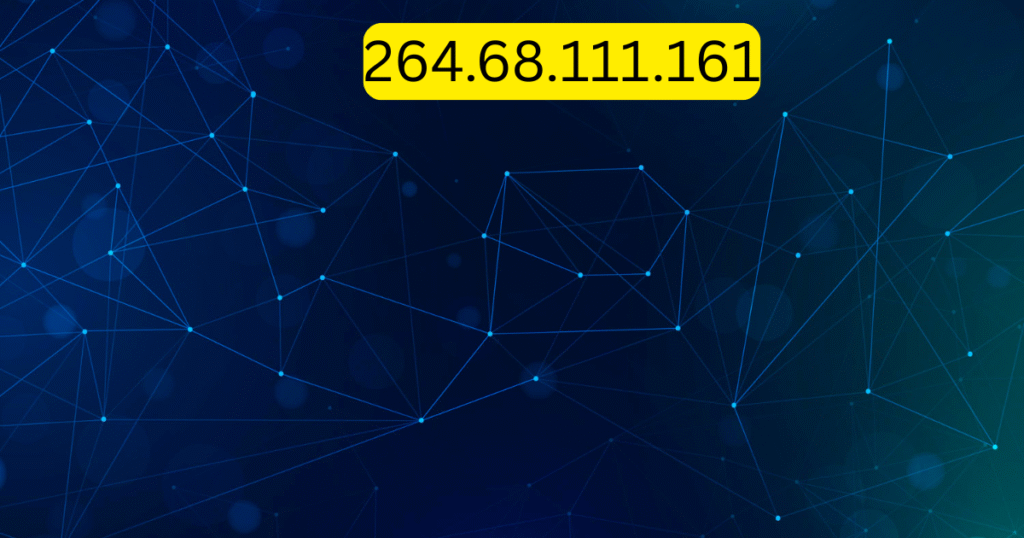Ever stumbled across the numbers 264.68.111.161 and wondered what they actually mean? At first glance, they might just look like a random string of digits. But there’s more to them than meets the eye—especially if you’re diving into the world of internet servers and IP addresses.
Let’s break it all down into everyday language. No tech jargon, no confusing explanations—just simple, straightforward insights to help you understand what this number string is all about and why it might matter to you.
What is 264.68.111.161? (And Why Should You Care?)
To begin with, 264.68.111.161 is formatted like an IP address. In fact, it looks just like one of those web-based addresses that help computers find each other online. But here’s the twist — it’s not actually a valid IPv4 address.
Why Not?
IPv4 addresses—the kind most of the internet uses—have four sets of numbers separated by dots. Each of those numbers must be between 0 and 255. In this case, 264 is over the limit. That’s the first clue something’s off.
So, what does that mean for you? Well, if you’ve seen a URL or log referring to 264.68.111.161, chances are it’s either a typo, a placeholder, or perhaps it’s being used to illustrate something else—like a fictional example in a tech tutorial or explanation.
Let’s go deeper.
Understanding IP Addresses: A Quick Refresher
To get a better grasp of what’s going on, it helps to understand what an IP address actually is. Think of it like a home address—but for your device on the internet.
Every device connected to the web (your phone, your smart fridge, even the vending machine at some offices) has an IP address. It’s how data knows where to go and how your messages know where they came from.
There are two main types of IP addresses:
- IPv4: These have four number blocks (like 192.168.1.1), each block ranging from 0 to 255.
- IPv6: The newer version with much longer strings, created as we started to run out of IPv4 addresses.
So, going back to 264.68.111.161: the first number “264” isn’t allowed in standard IPv4 addresses, making it technically invalid.
Could It Be IPv6?
Good question! But, no—IPv6 doesn’t look like this. IPv6 addresses include numbers and letters, and they use colons—not periods. So, it’s safe to say this isn’t an IPv6 address either.
Then What Could It Be?
It could fall into one of several categories:
- A Typo: Maybe someone meant to type 254.68.111.161—a valid IPv4 address—but they hit the wrong number.
- A Placeholder: Writers and developers sometimes use fake addresses in examples or tutorials so people don’t accidentally tap into a real server.
- Part of a Private Network or Simulation: It might be something used internally somewhere for demonstration or testing.
If you’ve seen this IP in your server logs or browsing history, it’s a good idea to double-check it. There’s a chance it’s part of some misconfiguration or even something suspicious—so don’t ignore it.
How to Check Validity of an IP Address
Not sure whether an IP is legitimate? There are online tools for that. Just search for “IP address checker” or “IP lookup tool,” and you’ll find plenty of free resources. Simply plug in the address, and it’ll tell you whether it’s real, where it’s from, and what organization it’s tied to—if any.
But keep in mind, fake addresses or typos (like 264.68.111.161) will show errors or default messages. That’s your clue that something isn’t quite right.
What If You Encounter 264.68.111.161 Online?
If you see this number used inside code, a tutorial, or documentation—don’t panic. Odds are, it’s just being used as an example. But if it shows up in your server logs or traffic history?
Then you might want to dig a little deeper. Malicious bots and hackers sometimes use fake IPs to mask their actions or test vulnerabilities. It’s not super common, but it’s better to be safe than sorry.
How to Protect Yourself
Here are some quick tips to stay safe online:
- Use firewalls and antivirus software that let you block suspicious IP addresses.
- Keep your systems and software updated to close any security gaps hackers can exploit.
- Regularly check logs and monitor your network for strange activity.
I once had a buddy who ran a small online store, and one day he noticed weird spikes in traffic from unknown IPs. With a bit of detective work—and the help of a good firewall—he discovered bots trying to scrape his product data. Thankfully, he caught it in time!
The Final Verdict: Should You Worry About 264.68.111.161?
Most likely—not. It’s not a valid IP address, and in most cases, you’ll only see it used for educational or illustrative purposes. But if it does pop up somewhere unexpected—say in your site’s logs or while browsing—take a closer look. Better to verify than leave it alone and regret it later.
Key Takeaways
- 264.68.111.161 is not a valid IPv4 or IPv6 address due to “264” exceeding the IPv4 limit.
- It’s often used as a placeholder, typo, or demonstration address.
- If found in real-world applications, check for typos or suspicious activity.
- Stay safe by regularly monitoring your digital environment and using solid security tools.
Conclusion
While it may seem like just a random bunch of numbers, 264.68.111.161 serves as a useful reminder of how critical attention to detail is in tech and on the internet. Just one wrong digit can mean the difference between a working connection and a big headache.
Have you encountered unusual IP addresses before? Or maybe had to troubleshoot one that turned out to be malicious or misformatted? Share your experience in the comments—we’d love to hear your story!
Remember: When it comes to the internet, even numbers have a story to tell.
